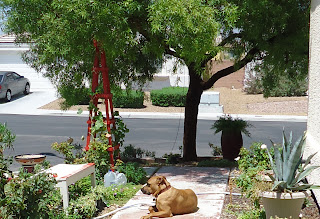 C ommonly known as the
"dog days," the mid-summer period does conjure images of a dog
lolling in the shade with tongue panting. The expression is ancient,
originating in stellar observations. During the sultriest days of summer, the Dog
Star "Sirius" made conjunction with the sun; the "dog days"
extended from about July 3 through August 11 in the Mediterranean. Heat and
lack of rainfall caused challenges to human and plant comfort then.
C ommonly known as the
"dog days," the mid-summer period does conjure images of a dog
lolling in the shade with tongue panting. The expression is ancient,
originating in stellar observations. During the sultriest days of summer, the Dog
Star "Sirius" made conjunction with the sun; the "dog days"
extended from about July 3 through August 11 in the Mediterranean. Heat and
lack of rainfall caused challenges to human and plant comfort then.
When the days get very hot and the gardeners
are so sweaty that even their hands sweat, most plants, with exception of a few
that like to bloom at this time like the Rudbeckia and the perennial
hibiscus, slow down. Even if deadheaded, they rebloom more slowly. These
are “the dog days” of August. I wondered what this phrase means and
where it comes from, so I did a bit of research.
The ancient Romans thought these
hottest and most sultry days of the year were an evil time causing “the sea to
boil and the wine to sour.” They “made dogs mad and other creatures languid,
gave humans disease, burning fevers, hysterics and phrensies.”
For
most of the USA, the "dog days" certainly extend through August and
even into September, when rainfall dips to nearly nothing. Some September
rainfall records note "a trace" fell. To protect the environment
during these driest of months, avoid making fires. Many municipalities put out
outdoor burn bans. This means no burning of "residential yard debris, no
burn barrels, and no recreational fires" until further notice.
At
this time of year many U-Pick farms where you can buy and pick the freshest and
most luscious of crops. Also take
advantage of your local farmer's markets and in your area. Let yourself know this region by shopping for
local produce now.
Care
for strawberries this month. If the entire crop bore fruit in June and is now
out of bloom, keep them watered this month because they are setting up fruit
buds for next year. Fertilize the entire patch with 5-10-10 at the rate of
about 3 pounds per 100 square feet of strawberry plants. Fall-bearing or
ever-bearing strawberries like 'Tri-Star' need monthly fertilizing and regular
water until rains come. It's easy to neglect a patch of strawberries after
harvest is over, but neglect now results in small or missing fruit next year.
Do
your own observations of plant growth during August. You'll notice that the
deep green of spring and summer leaves begins to alter. Many leaves show khaki tinged,
or begin to turn color. This change reflects normal cycles in plant growth. The
"big push" of leaf and shoot grow now slows down. Toward the middle
and end of August, plants begin to go dormant, slowly ceasing their growth and
moving carbohydrates toward the roots for winter. At this point, mature and
established trees and shrubs require less water and fewer nutrients. Don't
fertilize landscape trees and shrubs after about the
first of August. You don't want to force new growth that could be killed by
winter freezes. By slowing their growth now, mature plants prepare themselves
for the next season.
Some careful gardeners say that they
water in hot weather according to "triage," choosing those plants
with the most need. Container plants, new landscapes, new lawns, transplanted
material, and vegetable gardens will all need thorough watering during the hot
dry days of August. Check plants under eaves, too.
Often it's difficult to tell what a
plant symptom means. (Master Gardeners can help!) Yellowing leaves can result
from too little or too much water. If ground stays soaked, such as might happen
in an area where an irrigation system leaks, roots may rot and the result can
be yellowing leaves that precisely mimic those created by drought. Dryness can
also lead to symptoms of nutrient deficiency. Leaves may show yellowing between
green veins or yellowing of the entire leaf on older leaves. Plant nutrients
must be taken into the roots in solution. Lack of water will keep the nutrients
from penetrating. Do not fertilize plants if they won't be kept watered.


No comments:
Post a Comment
Please leave a comment or ask a gardening question.